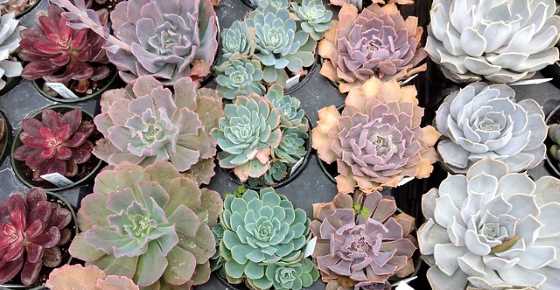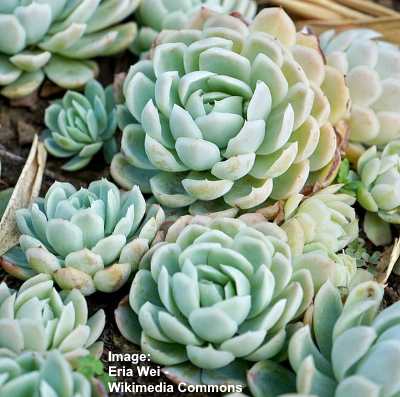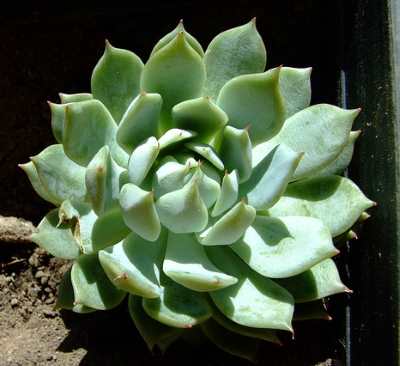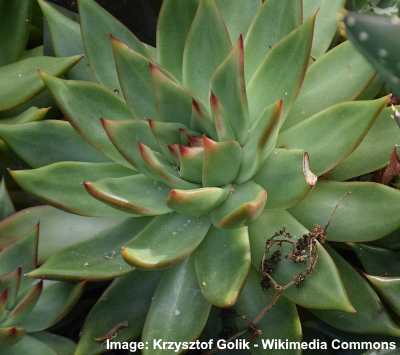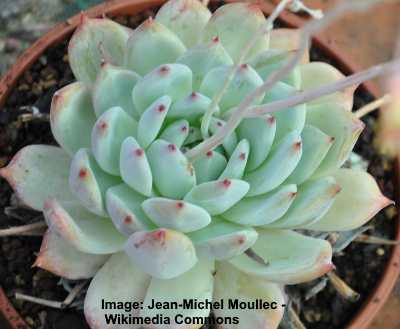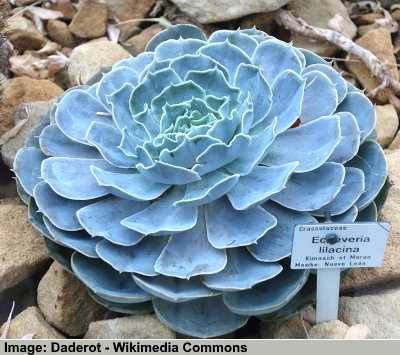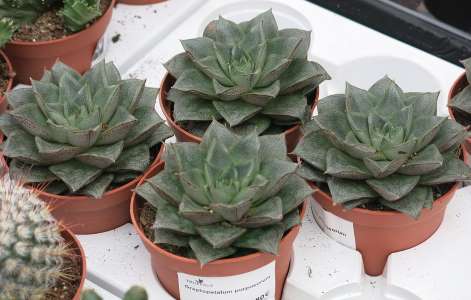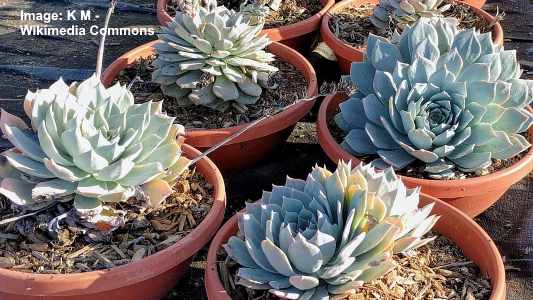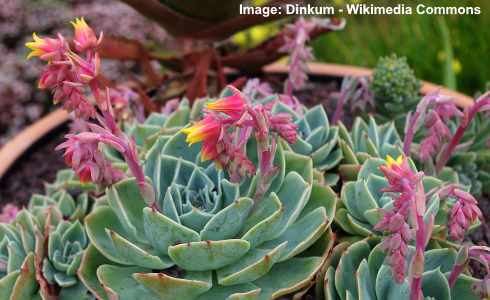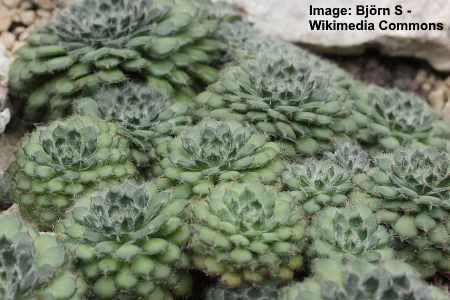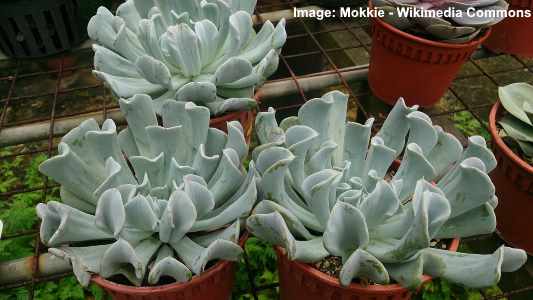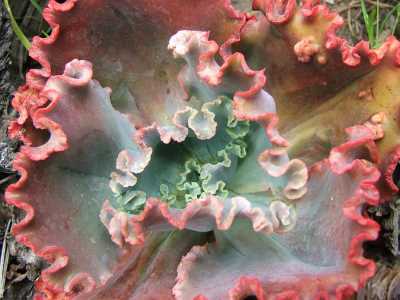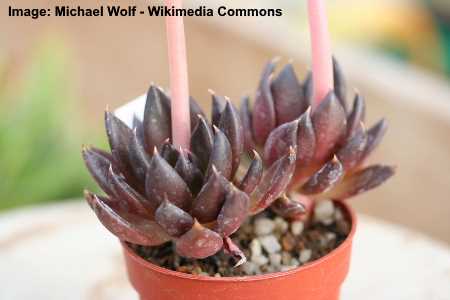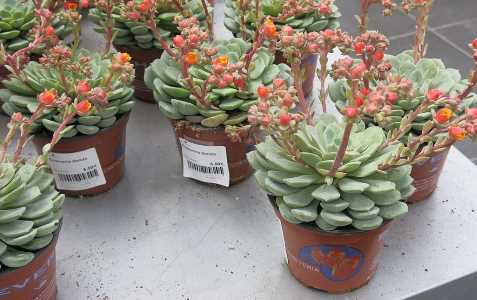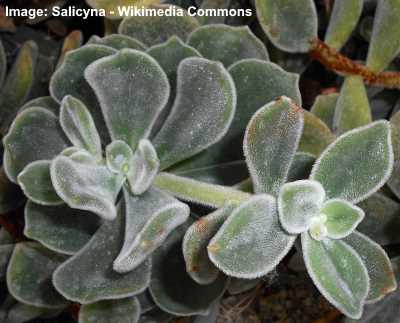Echeveria Types and How to Care for Echeveria Succulents (With Pictures)

Echeverias are some of the most popular types of succulents for your home or garden. These compact fleshy leafed plants are easy to care for, look beautiful, and don’t need a lot of water. The classic type of echeveria has a rosette shape with small triangular leaves. One of the reasons echeverias are common succulents is that they come in a wide range of colors, shapes, and textures.
Echeveria is a large genus of tropical flowering succulent plant in the family Crassulaceae. There are an estimated 150 species of echeveria and they are native to Mexico and Central America. Species of echeveria succulents generally have thick green fleshy leaves. There are some echeveria species with blue, silvery-green, light purple, light pink, gray, or light red leaves.
Because of their low-growing nature and stylish look, echeverias make great houseplants. You can plant a few different kinds of echeveria together or plant them with other succulents or cacti for an attractive plant display. Echeverias also love the sun, so they make decorative plants for windowsills, bright areas, desks, and patios.
How to care for echeveria plants: For echeverias to thrive, grow in bright indirect light and plant in well-draining cactus/succulents potting soil. Only water when the topsoil is completely dry and keep around 40% – 50% humidity. The ideal temperature range is between 65 and 80°F (18 – 27°C). Fertilize with diluted low-nitrogen mix every 3 weeks in the summer.
If you are wondering what kind of succulent you have, this article will help you identify the most popular types of echeverias.
There Are Many Types of Echeveria Succulents to Choose From
Many people regard echeverias as one of the most beautiful types of succulents. The sheer number of species in many different sizes and colors mean there are so many to choose from. You can recognize echeverias by their rosette shape and plump fleshy leaves.
You can choose from echeverias that have attractive rosette shapes and gray-green leaves, or kinds that look like ruffled lettuce, or also varieties of spiky star-shaped succulents. You can also choose from echeveria succulents that are in shades of red, green, grayish-blue, pink, and silver-white. There are even variegated types of echeverias with multicolored leaves.
Echeveria plants are also a type of flowering succulent plant that produces bell-shaped flowers. Long thin stems emerge from the compact rosettes that have beautiful pink, orange, or peach-colored flowers.
Some of the most popular echeverias are also called ‘hens and chicks.’ The “chicks” are smaller clones or ‘offsets’ that the mother plant (the “hen”) produces.
Related: The Most Gorgeous Succulents to Grow Outdoors or Indoors
How to Care for Echeveria Succulents (Echeveria Care Guide)
One of the beauties of growing echeveria succulents is that they are very low-maintenance. Even though the plants are easy to care for, there are some things to be aware of.
Echeveria watering
Like all succulents, echeverias store water in their fleshy leaves. During the spring and summer, they need regular watering to help them thrive. However, they should not be kept in damp soil.
Water your echeveria when about 1” (2.5 cm) of the soil on the top is dry. Pour water through the soil until it drains out of the bottom of the pot. After you have done this, don’t water again until the soil on the top has dried out. Always remember to water the soil, not the leaves.
During the winter, only water your echeveria sparingly.
If you water too much or too little, your echeveria will start to wilt, wrinkle, or drop leaves.
Echeveria succulent light requirements
Because echeverias originate in tropical countries, they need full sun to grow well. So, place your echeveria where it gets bright light and a few hours a day of direct sunlight.
If you have your echeveria on a windowsill, turn the plant occasionally to ensure that all sides of your plant get enough sun. Too many hours of hot, direct sunlight can result in sunburn.
Climate
Echeverias grow well indoors in average room conditions with around 40% – 50% humidity. During the spring and summer months, your indoor succulents need temperatures of between 65 and 80°F (18 – 27°C). During the winter, a few degrees lower will be ideal.
You can grow echeverias outside if you have warm summers of at least 19°C or 20°C.
Soil
Because cacti are also succulents, soil for cactus potting is also ideal for succulents. If growing in containers, make sure there are drainage holes in the bottom to allow water to drain from the soil. Soil that is constantly damp or doesn’t drain well results in echeveria root rot.
Fertilizer for echeveria care
Generally, echeverias grow well in most types of soil and don’t require any feeding.
However, if you want to encourage healthy echeveria growth, you can use low-nitrogen mix that has been diluted 3 or 4 times more than the recommended dose. Only feed your echeveria a small amount every 2 or 3 weeks throughout the summer.
Container size
When choosing an echeveria to grow in a pot or container, it is important to choose the right size. As a rule of thumb for all succulents, choose a pot that is just larger than the root ball. This helps to ensure soil doesn’t stay too damp.
Does Echeveria Need Grooming and Pruning?
Being an easy to care for species of succulent, echeverias are self-pruning. The only care they need is to occasionally wipe dust off with a damp cloth and to remove any dead leaves or flowers.
Common Issues with Echeveria Care
Proper watering is the best way to avoid any kind of problem with your pretty echeveria plants.
Succulent leaves turning yellow, brown, or falling off
If you notice that leaves are falling off, are wilting, turning yellow, or turning brown, it could be an issue with watering. Too much watering or too little watering can all affect the health of your echeveria.
One reason why echeveria leaves can become stretched and lose their color is low light. Always keep your echeveria succulents in bright rooms where they get plenty of sunlight. However, be aware that too much intense sunlight can burn the leaves, causing them to turn brown and patchy.
Mealybugs
Another common issue with caring for echeveria is an invasion of mealybugs. These tiny insects can feed on the plants and affect their growth. To solve this problem, use a natural insecticide, or add a little bit of dish soap to water and spray the succulent thoroughly.
Continue to spray them until the infestation has gone. If you have a large infestation, you may want to spray over the soil to get rid of any mealybugs or eggs that are still in the soil.
Types of Echeveria (With Pictures)
What is the perfect echeveria to grow in your garden or house? Read the descriptions and view the pictures of the most popular and colorful echeverias to find out which is the best succulent for you.
Echeveria Elegans
Also called the ‘Mexican Snow Ball,’ the Echeveria elegans is an evergreen perennial succulent. The thick fleshy pale-green leaves are in an open rosette shape and look similar to a large pine cone. This elegant succulent sprouts 10-inch (25 cm) long pink flowering stalks in winter or spring.
Echeveria ‘Lola’
One of the prettiest of the echeveria succulents is the ‘Lola’ species. This plant is in the shape of a rosebud and grows to about 6” (15 cm) tall. The greenish-gray leaves are ovate-shaped and may develop pink blushing when growing in full sunlight.
Echeveria Deranosa
The Echeveria Deranosa is a cute compact Mexican echeveria species that has the classic gray-green leaves of many succulents. Around the leaf edges you will notice beautiful pink coloring. The succulent leaves fan out to create a distinct rosette shape.
Echeveria Agavoides (Molded Wax Agave)
The ‘Molded Wax Agave’ is the common name for the echeveria species Echeveria agavoides. The thick triangular leaves are pale green and have a red pointed tip. The botanical name for this succulent literally means ‘looking like an agave.’ Pink, red, or orange flowers appear in the summer.
Another interesting type of ‘Molded Wax Agave’ is the crested species (Echeveria agavoides f. cristata). This has small spiky leaves that grow in clumps to give the plant a jaggy appearance.
Echeveria Colorata
This species of flowering echeveria, the Echeveria Colorata, is a large succulent that grows up to 16” (40 cm) in diameter. The red-tipped silvery-green leaves are lance-shaped and arch upward. This elegant echeveria will add a touch of class and style to your room, office, or windowsill.
Echeveria Galaxy Blue
The ‘Galaxy Blue’ echeveria is one of the more interesting succulents with large blueish wavy leaves and delicate red tips. The large leaves fan out from the center to create a showy open rosette. The succulent plant can reach up to 8” (20 cm) in diameter. If you are looking for an icy-blue succulent that grabs attention, then the ‘Galaxy Blue’ is a great choice.
Echeveria Lilacina
The Echeveria lilacina is commonly called the ‘Ghost Echeveria’ or ‘Mexican Hens and Chicks.’ The silver-grey compact rosette head resembles an artichoke head. Each silvery fleshy leaf is spoon-shaped and tapers to a red point. This large echeveria species can grow to 6” (15 cm) and between 4.7” and 10” (12 – 25 cm) in diameter. When this ‘hens and chicks’ echeveria flowers, the blossoms are pink, coral-colored bells.
Echeveria Purpusorum
The rosette shape of the Echiveria pruposorum has a definite spiky look to it. The small ovate fleshy leaves are packed together to create this charming plant. One of the delightful features is the leaf pattern. Leaves can be olive-green or gray-green and have brownish-red spots. A long stem from the center of the plant has small orange flowers on it when it blooms.
Echeveria Peacockii
The Echeveria Peacockii is also classified as the Echeveria desmetiana and is rosette-shaped echeveria with silvery-green, red tipped leaves. This succulent has oblanceolate-shaped leaves that create a beautiful rosette. The leaves can grow up to 2” (5 cm) long and the rosette shape is 4.5” (11 cm) in diameter.
One of the more interesting species of Echeveria peacockii is the variegated variety. This has delightful light gray-green and pale-yellow leaves.
Echeveria Secunda
The beauty of the Echeveria Secunda is the perfectly formed oval rosette with pale blue oval leaves. Around the edges of the succulent leaves are pink or red markings that add to its prettiness. A mature Secunda echeveria will be about 6” (15 cm) wide and measure about the same height. These succulents make for beautiful house plants or good ground cover for rock gardens.
Echeveria Setosa (Mexican Firecracker)
The ‘Mexican Firecracker’ (Echeveria setosa) is a fuzzy echeveria due to the fine white hairs covering the green leaves. Apart from its hairy appearance, identification of this succulent is by the red tips on the spoon-shaped leaves. This large echeveria species grows up to 12” (30 cm) wide and 2” (4 cm) high.
Echeveria Runyonii ‘Topsy Turvy’
The ‘Topsy Turvy’ cultivar from the Echeveria runyonii species has silvery spoon-shaped leaves forming a starry rosette. When you look at the succulent from the side, you notice that the leaves bend down along their length but point upwards at their tip. This makes the ‘Topsy Turvy’ one of the showiest succulents you can grow. This is a fast-growing species of echeveria that looks beautiful in a container or provides good ground cover in a rock garden.
Echeveria Cubic Frost
Another spectacular looking echeveria succulent is the ‘Cubic Frost’ cultivar. This succulent is an almost spherical shape with light lilac wavy leaves. Some of the thick leaves can be an icy-blue color with hints of pink blushing. Put the succulent in full sun to help fully bring out the pinkness in the leaves.
Compared to many other succulents, the ‘Cubic Frost’ has some of the most unusually shaped leaves you will find.
The large clusters of rosettes can be up to 10” (25 cm) in diameter. The succulent becomes even more stunning when it produces vivid orange-colored flowers.
Echeveria Joy’s Giant
The appropriately named ‘Joy’s Giant’ echeveria is one of the largest on this list. The massive lilac-tinted leaves with pink blushing form a rosette that can be up to 20” (50 cm) across. While this echeveria may be too large to grow indoors, it can make a stunning centerpiece in a cactus garden.
Echeveria ‘Bumps’
The appearance of this echeveria resembles more like kale or lettuce than the classic echeveria shape. The bumpy leaves have wavy ruffled edges and a distinct disheveled look. The leaves can also be a mixture of colors including green, deep pink, blue, or lilac. These striking examples of echeverias look wonderful in pots on your windowsill or in a succulent rock garden.
Echeveria ‘Gorgon’s Grotto’
Another type of succulent that resembles lettuce leaves is the ‘Gorgon’s Grotto’ echeveria cultivar. This succulent is identified by its wavy crinkled leaves and burgundy or deep pink colors. The large wide leaves fan out and curl up at the tips to give the fleshy plant a showy appearance. Expect these large echeverias to grow up to 12” (30 cm) in diameter and 10” tall.
Echeveria ‘Lipstick’
One of the most eye-catching types of echeveria from the Agavoides species is the ‘Echeveria Lipstick.’ This looks like a red type of echeveria due to the deep red leaves. Although the leaves are half-green, the bright crimson on the tops of the leaves makes the rosettes appear as if they are on fire.
Echeveria Affinis
Looking at images of the Echeveria Affinis, it is easy to see why they are called the ‘Black Echeveria.’ The lance-shaped spiky leaves are green-olive colored near the center that turn deep purple, almost black at the tips. This perennial succulent grows up to 8” (20 cm) wide and the same tall.
Echeveria ‘Dondo’
A common echeveria species with waxy light green, tightly packed leaves is the ‘Dondo’ echeveria. The leaves tend to be elongated oval and sometimes have a red tip. The small rosette shape is very compact and produces a number of flowering stalks in late winter and early spring.
Echeveria pulvinata
Also called the Chenille plant or Plush plant, the Echeveria Pulvinata is a small shrub-like succulent species. Although there are no outstanding features of its plump fleshy leaves, they have furry appearance. Tiny hairs cover the green leaves to make this one of the few fuzzy echeveria species you can grow. This succulent grows to about 12” (30 cm) tall and has a spreading nature.
Echeveria ‘Baron Bold’
The ‘Baron Bold’ echeveria is identified by its reddish-pink bumpy leaves that have a warty texture. The rosette succulent looks stunning in a pot and will grow up to 10” (25 cm) in diameter.
Echeveria ‘Fun Queen’
This evergreen succulent species is one of the few succulents that are characterized by pale pink leaves. Although there are hints of green in the leaves, pink is the dominant color of these succulents. The tiny echeverias grow up to 2” (5 cm) in diameter and only about 1” (2.5 cm) tall.
Echeveria ‘Encantada’
The echeveria ‘Encantada’ has a distinct frosty appearance due to the pale, icy-blue leaves in the shape of a teardrop. The compact leaves grow together to form a beautiful light blue rosette that has an impressive size of 15” (37 cm) wide. Its beauty is enhanced when the echeveria sprouts pale-blue or pink stems that have tulip-shaped orange flowers on the end.
Related articles:

